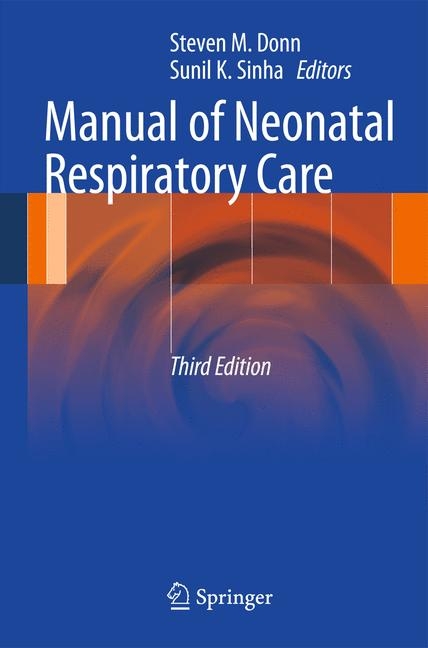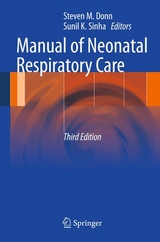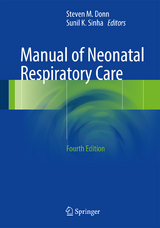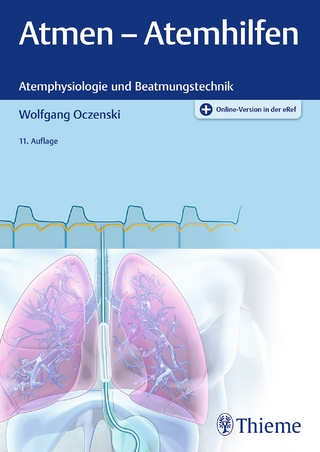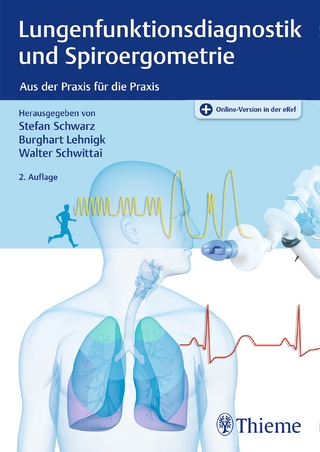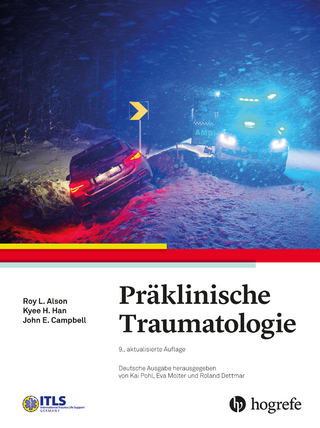Manual of Neonatal Respiratory Care
Springer-Verlag New York Inc.
978-1-4614-2154-2 (ISBN)
- Titel erscheint in neuer Auflage
- Artikel merken
Steven M. Donn, MD, FAAP Professor of Pediatrics University of Michigan School of Medicine Division of Neonatal-Perinatal Medicine C.S. Mott Children's Hospital Ann Arbor, MI, USA Sunil K. Sinha, MD, PhD, FRCP, FRCPCH Professor of Pediatrics University of Durham Consultant in Pediatrics and Neonatal Medicine The James Cook University Hospital Department of Neonatal Medicine Middlesbrough, Marton-in-Cleveland United Kingdom
SECTION I. Lung Development and Maldevelopment.- Chapter 1. Development of the Respiratory System.- Chapter 2. Developmental Lung Anomalies.- SECTION II. Principles of Mechanical Ventilation.- Chapter 3. Spontaneous Breathing.- Chapter 4. Pulmonary Gas Exchange.- Chapter 5. Oxygen Therapy.- Chapter 6. Oxygen Toxicity.- Chapter 7. Pulmonary Mechanics.- Chapter 8. Basic Principles of Mechanical Ventilation.- Chapter 9. Classification of Mechanical Ventilation Devices.- Chapter 10. Ventilator Parameters.- Chapter 11. Respiratory Gas Conditioning and Humidification.- SECTION III. Procedures and Techniques.- Chapter 12. Clinical Examination.- Chapter 13. Neonatal Resuscitation.- Chapter 14. Laryngoscopy and Endotracheal Intubation.- Chapter 15. Vascular Access.- Chapter 16. Tracheostomy.- SECTION IV. Monitoring the Ventilated Patient.- Chapter 17. Continuous Monitoring Techniques.- Chapter 18. Pulse Oximetry.- Chapter 19. Interpretation of Blood Gases.- Chapter 20. Neonatal Pulmonary Graphics.- Chapter 21. Radiography.- Chapter 22. Transillumination.- Chapter 23. Echocardiography.- Chapter 24. Bronchoscopy.- SECTION V. Non-Invasive Ventilatory Techniques.- Chapter 25. Nasal Cannula Therapy.- Chapter 26. Continuous Positive Airway Pressure.- Chapter 27. Non-invasive Ventilation.- SECTION VI. Ventilatory Modes and Modalities.- Chapter 28. Positive End Expiratory Pressure.- Chapter 29. Intermittent Mandatory Ventilation.- Chapter 30. Synchronized Intermittent Mandatory Ventilation.- Chapter 31. Assist/Control Ventilation.- Chapter 32. Volume-Targeted Ventilation.- Chapter 33. Pressure Control Ventilation.- Chapter 34. Pressure Support Ventilation.- Chapter 35. Proportional Assist Ventilation.- SECTION VII. High-Frequency Ventilation.- Chapter 36. High-Frequency Ventilation: General Concepts.- Chapter 37. High-Frequency Jet Ventilation.- Chapter 38. High-Frequency Oscillatory Ventilation.- SECTION VIII. Commonly Used Neonatal Ventilators.- Chapter 39. VIP BIRD Gold Ventilator.- Chapter 40. AVEA Ventilator.- Chapter 41. Bear Cub 750psv.- Chapter 42. Newport Wave.- Chapter 43. Newport e360T.- Chapter 44. Draeger Babylog VN500 Infant and Pediatric Ventilator.- Chapter 45. Servo-i Ventilator/NAVA.- Chapter 46. SLE 5000 and SLE 4000 Infant Ventilators.- Chapter 47. Bunnell Life-Pulse High-Frequency Jet Ventilator.- Chapter 48. SensorMedics 3100A High-Frequency Oscillatory Ventilator.- SECTION IX. Adjunctive Therapies.- Chapter 49. Hemodynamic Support.- Chapter 50. Nutritional Support of Ventilated Infants.- Chapter 51. Surfactant Replacement Therapy.- Chapter 52. Pharmacologic Agents.- Chapter 53. Automatic Control of Oxygen Delivery.- Chapter 54. Sedation and Analgesia.- Chapter 55. Inhaled Nitric Oxide Therapy.- Chapter 56. Extracorporeal Membrane Oxygenation.- Chapter 57. Liquid Ventilation for Neonatal Respiratory Failure.- SECTION X. Management of Common Neonatal Respiratory Diseases.- Chapter 58.Mechanisms of Respiratory Failure.- Chapter 59. Tissue Hypoxia.- Chapter 60. Indications for Mechanical Ventilation.- Chapter 61. Respiratory Distress Syndrome.- Chapter 62. Pneumonia.- Chapter 63. Meconium Aspiration Syndrome.- Chapter 64. Persistent Pulmonary Hypertension of the Newborn.- Chapter 65. Congenital Diaphragmatic Hernia.- Chapter 66. Pulmonary Hypoplasia/Agenesis.- Chapter 67. Apnea Syndromes.- Chapter 68. Weaning and Extubation.- SECTION XI. Bronchopulmonary Dysplasia.- Chapter 69. Etiology and Pathogenesis.- Chapter 70. Management.- Chapter 71. Long-Term Outcome of Newborns with Bronchopulmonary Dysplasia.- SECTION XII. Complications Associated With Mechanical Ventilation.- Chapter 72. Thoracic Air Leaks.- Chapter 73. Patent Ductus Arteriosus.- Chapter 74. Neonatal Pulmonary Hemorrhage.- Chapter 75. Retinopathy of Prematurity.- Chapter 76. Neurologic Complications of Mechanical Ventilation.- SECTION XIII. Other Considerations.- Chapter 77. Nursing Care of the Ventilated Infant.- Chapter 78. Transport of Ventilated Babies.- Chapter 79. Home Ventilation.- Chapter 80. Discharge Planning and Follow-Up of the NICU Graduate.- SECTION XIV. Ethical and Legal Considerations.- Chapter 81. Initiation of Life Support at the Border of Viability.- Chapter 82. Withdrawal of Ventilatory Support.- Chapter 83. Medical Liability, Documentation, and Risk Management.- SECTION XV. Research and the Literature.- Chapter 84. Interpreting Medical Literature.- Chapter 85. Contemporary Classics in Neonatal Respiratory Care.
| Erscheint lt. Verlag | 12.2.2012 |
|---|---|
| Zusatzinfo | 120 black & white illustrations, 27 colour illustrations, 53 black & white tables, biography |
| Verlagsort | New York, NY |
| Sprache | englisch |
| Maße | 155 x 235 mm |
| Gewicht | 1235 g |
| Themenwelt | Medizin / Pharmazie ► Medizinische Fachgebiete ► Anästhesie |
| Medizinische Fachgebiete ► Innere Medizin ► Pneumologie | |
| Medizin / Pharmazie ► Medizinische Fachgebiete ► Intensivmedizin | |
| Medizin / Pharmazie ► Medizinische Fachgebiete ► Notfallmedizin | |
| Medizin / Pharmazie ► Medizinische Fachgebiete ► Pädiatrie | |
| Schlagworte | Atemwege • mechanical ventilation • Neonatal intensive care • Neugeborenes Kind • NICU • Respiratory Distress Syndrome • Respiratory Therapy |
| ISBN-10 | 1-4614-2154-3 / 1461421543 |
| ISBN-13 | 978-1-4614-2154-2 / 9781461421542 |
| Zustand | Neuware |
| Informationen gemäß Produktsicherheitsverordnung (GPSR) | |
| Haben Sie eine Frage zum Produkt? |
aus dem Bereich
